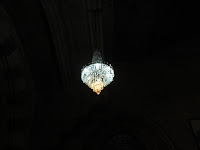The Line Begins Here
 Mumbai CST is one of the oldest and busiest railway stations in India. Its 125 year old history lends itself to adequate scrutiny and admiration from various angles. Hence, there is no wonder that Mumbai has largely been symbolized with the iconic structure that attracts large number of tourists, researchers, students, historians and scholars. One of the more interesting things I found in Mumbai CST was the Heritage Gallery. The Gallery has a mine of information and is a perfect way to explore the station on a humid afternoon. The walk begins with Bholu, the mascot of the Indian Railways welcoming the visitors into the gallery.
Mumbai CST is one of the oldest and busiest railway stations in India. Its 125 year old history lends itself to adequate scrutiny and admiration from various angles. Hence, there is no wonder that Mumbai has largely been symbolized with the iconic structure that attracts large number of tourists, researchers, students, historians and scholars. One of the more interesting things I found in Mumbai CST was the Heritage Gallery. The Gallery has a mine of information and is a perfect way to explore the station on a humid afternoon. The walk begins with Bholu, the mascot of the Indian Railways welcoming the visitors into the gallery. The conception along with the design began in October 2009 while the the site work began in November 2009 and was finally inaugurated for public viewing in January 2010. The gallery has been designed in a 1500 square feet centre for interpretation that would adequately compliment the world heritage site and is largely aimed at tourists who admired the building from outside and offers an opportunity to experience the growth of the 160 year old legacy of the
Indian Railways.
The entire display is arranged in sections that are chronologically arranged and the walk is divided into eight sections which track the subsequent development of Mumbai CST and the Central Railway that lend itself to being the main subjects on display and each section has a time capsule that is displayed in a manner that it recreates the period in question.
There is an old classic telephone that rings with the characteristic ringtone "tring-tring" and an old fan with 4 wings, a wooden chair that is still strong enough to hold weight, an old-time green coloured engine and its compartments marked in red. The engine and its compartments resemble playing toys and finally, there is a brass bell that was installed in 1866 at Neral railway station when guards used to ring such brass bells and indicators were also manual in the pre-digital era.
 The heritage gallery is a haven for photographers and the entire walk is designed, planned and coordinated with dedicated students from the nearby J.J. School of Architecture which is ably supported by the Central Railway. The walk allows access to the dining hall, the star chamber, the royal grand staircase on the second floor of the building, the forecourt and the concourse above the suburban booking office.
The heritage gallery is a haven for photographers and the entire walk is designed, planned and coordinated with dedicated students from the nearby J.J. School of Architecture which is ably supported by the Central Railway. The walk allows access to the dining hall, the star chamber, the royal grand staircase on the second floor of the building, the forecourt and the concourse above the suburban booking office. 
 Throughout the walk, visitors are permitted to click photographs. Among the more interesting paintings I found during the paintings were by Axel Haig along with some of original drawings of the erstwhile Victoria Terminus done by architect F.W. Stevens.
Throughout the walk, visitors are permitted to click photographs. Among the more interesting paintings I found during the paintings were by Axel Haig along with some of original drawings of the erstwhile Victoria Terminus done by architect F.W. Stevens. This is a paid tour with a nominal entry charge of Rs. 100/- for student who produce a valid identity car of a school, college or university and for other visitors, the heritage gallery charges Rs. 200/- . The heritage gallery is one of the many ways to get acquainted with the heritage of the city. It is a must visit for anyone interested in industrial history, the railways or architecture. It is open on all the seven days of the week from 3 pm to 5 pm.



Comments